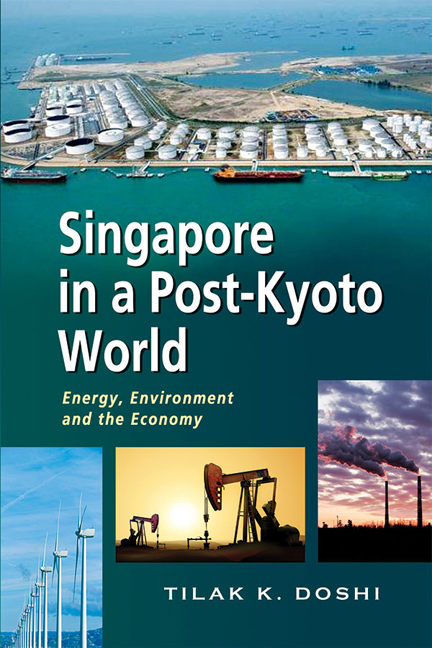Book contents
- Frontmatter
- Dedication
- Contents
- List of Tables and Figures
- Preface
- Acknowledgements
- List of Abbreviations
- Introduction
- 1 Economy, Energy, and Emissions
- 2 Climate Change Negotiations: From Copenhagen to Durban via Cancun
- 3 Climate Change Finance: Who Pays and Who Receives?
- 4 Singapore's External Sector: Impacts of Emission Mitigation Policies
- 5 Energy and Emissions: The Five Strategies
- 6 Concluding Remarks: “The Three E's”
- Index
- About the Author
2 - Climate Change Negotiations: From Copenhagen to Durban via Cancun
Published online by Cambridge University Press: 19 May 2017
- Frontmatter
- Dedication
- Contents
- List of Tables and Figures
- Preface
- Acknowledgements
- List of Abbreviations
- Introduction
- 1 Economy, Energy, and Emissions
- 2 Climate Change Negotiations: From Copenhagen to Durban via Cancun
- 3 Climate Change Finance: Who Pays and Who Receives?
- 4 Singapore's External Sector: Impacts of Emission Mitigation Policies
- 5 Energy and Emissions: The Five Strategies
- 6 Concluding Remarks: “The Three E's”
- Index
- About the Author
Summary
Each country's specific evolving pattern of energy-economy interactions will determine how various proposals on greenhouse gas (GHG) emission reductions will impact the economy. In preparing their negotiating positions, governments need to be informed of quantitative impacts on costs, prices, and export competitiveness, both at the sectoral and national levels. Planning agencies typically implement computable energy-economy models to deliver informed assessments of the probable impacts of various policies on emission mitigation and energy technology choices.
While quantitative estimates of various energy-economy models set a “baseline” of expected impacts that planning agencies need to know, negotiations in a strategic context, where one party's optimal choice is a function of the choice of other parties, are the focus of games-theoretic models in economics. Climate change is posed in these models as the ultimate global commons problem, with damages imposed on life and property globally being independent of the actual location of GHG emissions anywhere on the planet. Strategic behaviour is inherently hard to model, however, and game theory models are often highly abstract. However, a summary of the main results of the literature is useful in framing the overall context of United Nations Framework Convention on Climate Change (UNFCCC) negotiations.
Given that participants to an international environmental treaty are sovereign nation-states in the United Nations (UN) system, and given the absence of a supranational judicial institution with enforcement powers, the incentives to free ride would be strong for all participants. Given free ride incentives, countries will see advantages in being the last to commit to policy targets, hence risking coordination failure in negotiating agreements. In a large group (such as the UN), the incentives to free ride make the existence of a universal agreement, of net benefit to all countries and in stable equilibrium, highly unlikely. It is more likely that self-enforcing agreements emerge among limited groups of countries within different coalitions of different sizes. Since a global binding agreement is unlikely to be signed by all countries, a more credible scenario is that several parallel agreements emerge over time, much like the case in current international trade and economic cooperation negotiations. The failure in concluding World Trade Organization (WTO) agreements over a range of issues has led to continuous multilateral summits and negotiations for regional economic integration and a multiplicity of investment and trading agreements and blocs.
- Type
- Chapter
- Information
- Singapore in a Post-Kyoto WorldEnergy, Environment and the Economy, pp. 18 - 58Publisher: ISEAS–Yusof Ishak InstitutePrint publication year: 2015

